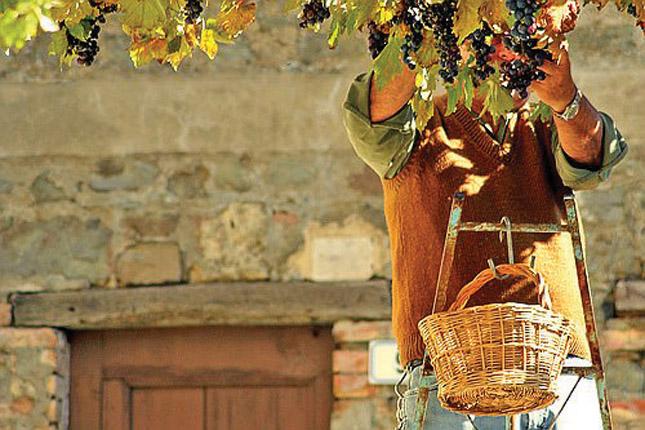Fall has arrived, and for American and European wineries, that means harvest time! Across the northern hemisphere, many wine regions are just wrapping up their harvest season while others are gearing up to start. This process can last anywhere from a couple of weeks to a couple of months, depending on the size of production and how uniformly the grapes ripen. In the weeks leading up to pickintg, workers in the vineyards are dropping clusters for flavor concentration, pruning back overgrown canopies, and measuring sugar and acid levels in the berries to predict the nature of the vintage. Cellar hands are meticulously sanitizing tanks, pumps, bins and presses to give the fruit the best chance to make superior wine. During this time, the anticipation slowly builds and winemakers pray for the rain, birds, and pests to hold off until the time has come to pick the grapes.
The unusual weather has made 2011 a chaotic year for viticulture across the board. Record high temperatures in Bordeaux led to one of the earliest harvests in the region’s history. California and Oregon are behind due to uncommonly cool summer months. And just imagine what Hurricane Irene has done to the East Coast wine regions.
But regardless of when the picking begins, harvest is always the toughest but most exciting and rewarding time of year in wine country. Most wineries welcome interns, often from all over the globe, and the whole team works long hours to get all the fruit in at its peak ripeness. Harvest always involves a lot of sweat and stress, but it also comes with an overabundance of fantastic meals, valuable friendships, and hard-earned pride in the vintage’s product.
The approach of fall weather finds any wine enthusiast excited about the varietals ideal for the season. While the heat of summer warrants bright steel-fermented whites and a D.C. winter seems to call for bigger, jammier reds and creamy Chardonnays, fall is the perfect time of year to choose wines that may not be as well-known, but that evoke the diversity of color, flavor, and complexity found in the foods and landscapes of the season.
The clearest parallel in a wine may be found in a classic Gewürztraminer from the appellation of Alsace, France. While Alsace is known for its crisp dry Riesling and full-bodied Pinot Gris that also pair well with autumn-inspired meals, the distinctive character of the Gewürztraminer grape fully embodies the spirit of fall. It has a color range from deep golden to almost coppery orange, and it’s one of the most aromatic varietals, showcasing a spectrum of flavors from spiced apple and pear to honeysuckle to lychee and nuts. Similar to Riesling, Gewürztraminer can be either sweet or dry, depending on the style of production. But all versions pair excellently with baked ham, roasted poultry, and meatier fish—think Thanksgiving!
One highly underrated and often misunderstood wine that finds an ideal stage this time of year is wine from Gamay (or Gamay Noir), the primary red grape found in the Beaujolais region of France. Gamay is usually a lighter-bodied wine in texture, but can be very full in flavor. A good Beaujolais from one of a handful of Crus-designated producers will display deep red fruit flavors, good acid structure, and layers of pepper and spice. Unfortunately many people only know the name Beaujolais for the marketing phenomenon of Beaujolais nouveau, a festival held in France in November celebrating the very first releases of the vintage. These are very light, fruity, and one-dimensional wines fun for the occasion but far from a high-end bottling. For a more refined and complex Gamay that pairs well with smoky meats and stews, look for the Crus domains such as Morgon or Côte du Brouilly, or you can also find comparable Gamays from a few Oregon producers such as Willakenzie Estate and Chehalem.
If you are looking for a red wine with more tannin structure and bigger fruit than a Gamay might offer, fall is the perfect time to start breaking out the Zinfandels. Mostly grown in a few California counties such as Sonoma and Amador, Zins are ripe-fruited full-bodied wines that can display rich earthy and savory flavors layered with blackberry, cocoa, cedar, and pepper, ideal to warm a chilly fall evening. A well-balanced Zinfandel will pair beautifully with heavier autumn dishes such as leg of lamb or traditional Italian lasagna.
Harvest time is always a time of celebration, whether it’s in the vineyard or in your own backyard garden. As the leaves take on their most vibrant and dynamic colors, use this opportunity to evolve your palate by exploring wines you’ve never tried. And as we say at the winery: wine is far better with fine food and good friends.
Caroline Jackson works for Chehalem Winery in Oregon’s Willamette Valley, with a background in East Coast wine sales and winemaking. Visit her blog, Sips and Sounds, which pairs daily music selections with a wine or craft beer.


